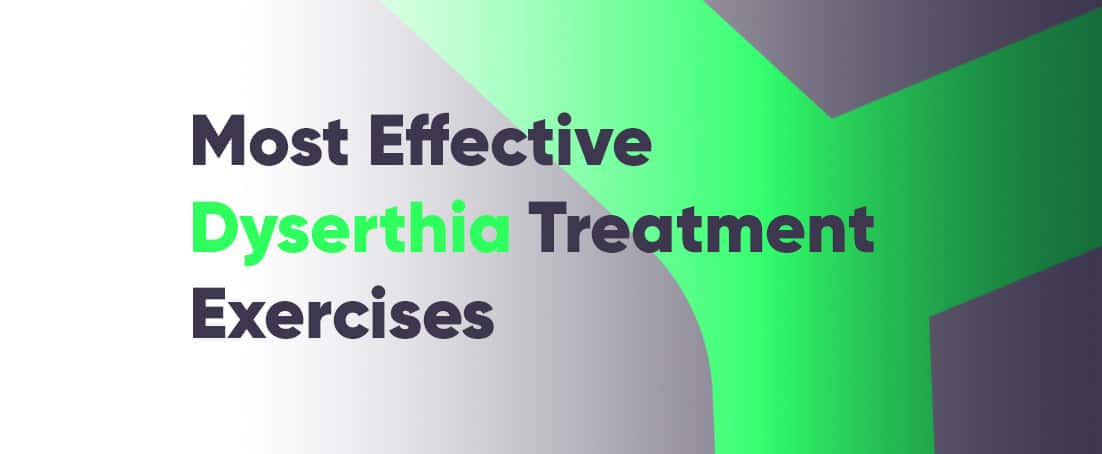Dysarthria is a speech disorder that makes it hard to speak clearly, control pitch and volume, and keep a steady pace. It can really impact communication and social interactions, affecting someone’s overall quality of life.
But there are exercises to help manage and improve speech clarity when dealing with communication disorders such as Dysarthria.
“Mewing” is a technique that has lately acquired popularity as a therapeutic exercise for dysarthria. Placing the tongue on the roof of the mouth can assist in strengthening the muscles involved in speech production and enhance overall speech clarity. If you wish to understand mewing better, and learn more about its benefits, take a quiz below.
In this article, we’ll also explore:
- 📝 What is dysarthria and how it affects speech production
- 👄 The importance of dysarthria treatment exercises
- ✔️ The benefits of mewing and other non-speech exercises

What Causes Dysarthria?
Motor speech disorders result from a damaged nervous system preventing the full control of particular body parts, in this case, the jaw, the tongue, and the larynx.
Dysarthria can be caused by a range of neurological conditions, injuries, and disorders that affect the parts of the brain responsible for controlling the muscles used in speech production such as the unilateral upper motor neuron.
Here are some of the most common causes of dysarthria:
- Stroke: A stroke is a serious condition that can cause damage to the brain and affect speech production, resulting in dysarthria.
- Traumatic Brain Injury: A severe head injury, such as a concussion or skull fracture, can also damage the brain and cause dysarthria.
- Neurodegenerative Diseases: Conditions such as Parkinson’s, multiple sclerosis, and ALS can cause degeneration of the nerves and muscles involved in speech production. Patients suffering from these medical conditions can have dysarthria.
- Brain Tumors: A tumor in the brain can cause dysarthria by interfering with the normal function of the speech muscles.
- Cerebral Palsy: This condition affects the brain’s development and can cause difficulties with motor function, including speech.
- Alcohol or Drug Abuse: Chronic use of alcohol or drugs resulting in dysarthria. They can cause damage to the brain and nerves involved in speech production.
- Infections: Certain infections, such as meningitis or encephalitis, can cause inflammation and damage to the brain that may lead to dysarthria.
- Medications: Some medications can affect the nerves and muscles used in speech production, causing dysarthria as a side effect.
Dysarthria: Types, Symptoms, and Treatment Approaches
Dysarthria is a speech disorder caused by damage or injury to the parts of the brain responsible for controlling the muscles used in speech production. There are different types of dysarthria, each with its own set of characteristics and treatment approaches.
Spastic Dysarthria Treatment
Spastic dysarthria is a motor speech disorder that results in slow, effortful speech with a harsh-sounding voice. Treatment focuses on strengthening weak muscles and improving articulation through exercises. Augmentative and alternative communication (AAC) devices can also be used as dysarthria treatment techniques.
Ataxic Dysarthria Treatment
Ataxic dysarthria is a motor speech disorder that causes slurred speech with irregular pauses and a lack of coordination in the speech muscles. Dysarthria exercises may help to improve speech by focusing on practicing rhythm and timing, breathing correctly, and using a monotone voice.
You may also use other approaches, like speaking at a slower pace and emphasizing sounds or words. Working with a speech-language pathologist can help individuals with ataxic dysarthria develop personalized dysarthria exercises for adults, such as word lists, to practice communication abilities.
Flaccid Dysarthria Treatment
Flaccid dysarthria is a motor speech disorder that results in weak, breathy speech with reduced volume and poor articulation. This type of dysarthria is caused by damage to the lower motor neurons or nerves that control the speech muscles.
Treatment exercises may aim to strengthen the speech muscles, improve breath control, and increase vocal resonance to improve speech quality.
Hyperkinetic Dysarthria Treatment
Hypokinetic dysarthria is a speech disorder often associated with Parkinson’s disease. It is characterized by speaking slowly, lacking inflection, and a reduced volume. The speech muscles become rigid and slow. This results in difficulty with exercising your facial expression and speech production.
Treatment exercises for hypokinetic dysarthria may include practicing loud and clear speech and improving breath support and vocal control.
Mixed Dysarthria Treatment
Mixed dysarthria is a complex condition that combines features of different types of dysarthria. It can present a unique challenge for speech-language pathologists as the symptoms vary depending on the specific combination of dysarthria types.
Treatment approaches for mixed dysarthria may involve a combination of exercises that target various speech subsystems, such as respiratory, phonatory, and articulatory systems. The treatment plan may also involve augmentative and alternative communication strategies to supplement speech.
9 Effective Dysarthria Treatment Exercises for Children and Adults
1. Orthotropics
Orthotropics or mewing refers to a set of lip and tongue exercises that aim to improve facial structure and overall oral posture. They involve techniques, such as tongue twisters and blowing bubbles, to strengthen the muscles by exercising your jaw.
Mobile apps are also available that promote mewing exercises and provide guidance on proper technique. One of them is our own product: Mewing.coach. The app is designed to provide users with a comprehensive guide to practicing mewing exercises to enhance their jawline and facial appearance.
The app offers a range of features, including instructional videos, progress tracking, and customized workout plans to help users achieve their desired results.
2. Exercises for Breathing Support
Breathing support exercises are methods that help improve the way air exits the lungs. These workouts sometimes entail activities such as blowing up balloons or blowing bubbles to develop the respiratory muscles.
These exercises can be especially beneficial for those who use their voice professionally, such as singers or public speakers, and those with respiratory problems, such as asthma.
3. Speaking Exercises
Different tongue exercises frequently include a variety of activities, such as singing, imitating animal sounds, or performing tongue twisters to help develop the muscles required for speaking.
Children and adults with dysarthria can enhance their speech sounds, breath support, and general facial expressions by completing these exercises on a daily basis. This may be achieved and aided by seeing an expert in speech-language pathology.
4. Expression or Enunciation Exercises
These exercises frequently involve repeating certain sounds, syllables, or phrases that can aid in improving articulation and speech clarity. Children and adults with dysarthria can enhance their capacity to speak and be understood by completing these activities on a daily basis. These exercises may be adjusted to each person’s specific requirements and speech therapy.
5. Steady and Overemphasized Speaking Drills
These exercises include practicing speaking slowly and deliberately, stressing each word and syllable to improve clarity and effectiveness. Individuals may enhance their enunciation, rhythm, and tempo by frequently doing these dysarthria exercises, making their speech more interesting and easier to comprehend.
6. Exercises for Improving Oral-Motor Skills
Oral-motor exercises are techniques for improving the function of the mouth and throat muscles, which can aid in speech, eating, and drinking. Strengthening the tongue, lips, and cheeks requires exercises that include chewing gum for jawline, sucking on straws, or blowing bubbles.
Individuals who practice these exercises on a regular basis can improve their oral-motor skills, allowing them to eat, speak, and communicate more effectively.
7. Improving Communication Skills Through Conversing with Family and Peers
In addition to dysarthria therapy activities, practicing communication skills with family members or peers can help enhance speaking ability. Conversation with others can assist people with fluency disorders in improving their articulation, vocal intensity, and conversation skills in a natural and comfortable situation.
Individuals may boost their confidence and ability to express themselves successfully in a range of contexts by practicing communication on a regular basis.
8. Implementing Communication Techniques
Exercises for dysarthria therapy are crucial for enhancing speech output in people with this speech problem. Incorporating communication techniques that can improve all aspects of communication, particularly for kids and adults with dysarthria, is equally crucial.
These tactics may include approaches like speaking more slowly, employing gestures or visual aids, and getting comfortable taking turns in conversations.
People with dysarthria can communicate more effectively in their daily lives, enhancing their quality of life and social connections by combining these tactics with dysarthria therapy activities. Overall, effective dysarthria treatment requires a thorough strategy that includes both speech production and communication techniques.
9. Use Visual or Technological Tools
These techniques can help people communicate in settings where speech is difficult or inefficient, such as in loud environments or with strangers. Speech-generating devices, for example, are electronic gadgets that may generate speech from text sentences or symbols that the user selects.
Communication boards, on the other hand, are actual boards containing symbols or pictures that people may point to in order to convey their message.
Other visual aids, in addition to these tools, can be beneficial to people who have disorders. Picture books, visual timetables, and other sorts of visual dysarthria treatment activities for adults.
Collaborating with a Speech Therapists
Collaboration with a speech-language therapist may be tremendously useful for people seeking dysarthria therapy. Speech therapists are skilled practitioners who specialize in diagnosing and treating voice disorders such as speech deficits.
Patients with dysarthria who work with a speech-language therapist can get compensatory strategies and focus on enhancing their speech intelligibility.
Some of the benefits of working with a speech-language therapist for differential diagnosis include:
- Assessment and Diagnosis: A speech-language therapist can conduct a comprehensive assessment to determine the specific type and severity of dysarthria, essential for developing an effective treatment plan.
- Tailored Treatment Plan: Based on the neurogenic speech disorders, a speech-language therapist can create a personalized treatment plan that is tailored to the individual’s specific needs and goals. Some may even recommend nonspeech exercises.
- Therapy and Exercises: Speech-language therapy for dysarthria may involve various exercises and techniques to improve articulation, voice production, and overall communication skills.
- Communication Strategies: A speech-language therapist can provide communication strategies and techniques to individuals with dysarthria to enhance their ability to communicate effectively in different situations.
- Support and Counseling: Working with a speech-language therapist can provide emotional support and counseling to help individuals cope with the challenges of living with dysarthria.
Working with a speech-language therapist may be a great resource for people with dysarthria who want to enhance their communication skills, quality of life, and general well-being. A therapist will also give you more information on other dysarthria-causing factors and general guidance on uneven lip exercises.
How Long Does it Take to Recover from Dysarthria?
The time it takes to recover from dysarthria varies substantially depending on the underlying cause and severity of the ailment. Dysarthria may be a transient ailment that cures on its own after a few days or weeks. However, in some cases, it may be a chronic condition that necessitates ongoing treatment and management.
Age, overall health, and the individual’s dedication to treatment can all impact the recovery duration for dysarthria. Individuals who receive early and consistent treatment for dysarthria tend to have better outcomes and recover faster.
Final Thoughts
Dysarthria treatment exercises are essential for improving communication skills and enhancing the quality of life for individuals with this speech disorder. Engaging in therapy with a speech-language therapist, using visual aids, and regular exercising can help to strengthen the muscles used in speech production and improve overall speech clarity.
Individuals with dysarthria need to seek professional help and exercise daily to achieve their communication goals and enhance their quality of life. By doing so, individuals with dysarthria can significantly improve their communication skills, confidence, and well-being.



